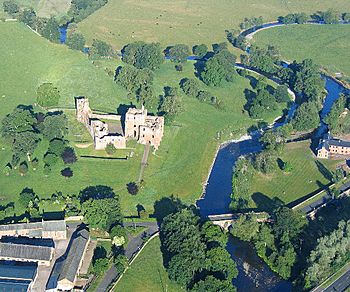River Lowther facts for kids
Quick facts for kids Lowther |
|
|---|---|

The River Lowther where it joins the River Eamont close to Brougham Castle
|
|
| Country | United Kingdom |
| Physical characteristics | |
| Main source | the confluence of the Keld Gill and the Keld Dub near the village of Keld |
| River mouth | confluence with River Eamont |
The River Lowther is a small river that flows through Cumbria, England. It's like a smaller stream that feeds into a bigger river. The Lowther joins the River Eamont, which then flows into the River Eden. The River Eden eventually reaches the sea at the Solway Firth, near the city of Carlisle.
The River Lowther starts when two smaller streams, the Keld Gill and the Keld Dub, meet near the village of Keld. This meeting point is called a confluence. From there, the river flows towards the north-west, passing between the villages of Bampton and Bampton Grange. It then turns north until it meets the River Eamont near Penrith.
This river is very important for fish. It's a main spawning area for spring salmon that live in the River Eden. A spawning area is where fish lay their eggs. The Lowther is also a popular place for catching trout. The river's flow is controlled by the Wet Sleddale dam, which helps keep the water level quite steady. The highest water level ever recorded on the River Lowther was 2.93 meters, which happened on December 6, 2015.
The name of the river, Lowther, was first written down around the year 1175 as Lauder. It might come from an old language called Old Norse. In Old Norse, lauðr means "foamy" and á means "river," so it could mean "foamy river." Another idea is that the name comes from an even older language called Common Brittonic. In Brittonic, lǭwadr means "a washing or bathing place." This would make its name similar to the town of Lauder in Scotland.
Contents
Villages and Towns Along the River Lowther
Many small villages and towns are located along the banks of the River Lowther. These places have grown up over time, often relying on the river for water or transport.
- Keld: Where the river begins.
- Rosgill
- Bampton Grange
- Bampton
- Askham
- Lowther
- Eamont Bridge
- Brougham
Cool Places to See Near the River Lowther
The area around the River Lowther is full of interesting historical sites and attractions. Many of these places are managed by groups like the National Trust or English Heritage, which help protect important historical sites.
- Keld Chapel (National Trust), Keld: A small, historic chapel.
- Shap Abbey, (English Heritage), near Shap: The ruins of an old abbey.
- Askham Hall, Askham: A historic house with beautiful gardens.
- Lowther Castle: The impressive ruins of a large castle.
- Castlesteads Ruins, Yarnwath Woods: Ancient ruins.
- King Arthur's Round Table Henge, Eamont Bridge: An ancient circular earthwork.
- Mayburgh Henge, Eamont Bridge: Another large, ancient stone circle.
- Brougham Hall: A historic country house.
- Brocavum Roman Camp: The remains of an old Roman fort.
- Brougham Castle (English Heritage): A well-preserved medieval castle.
Streams That Join the Lowther
Just like the Lowther joins the Eamont, several smaller streams, called tributaries, flow into the River Lowther.
- Swindale Beck
- Haweswater Beck
- Gill Beck
- Heltondale Beck
Images for kids


